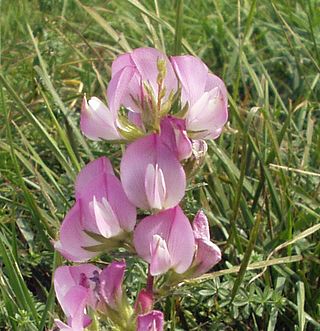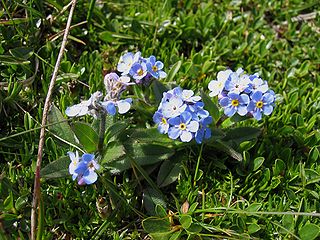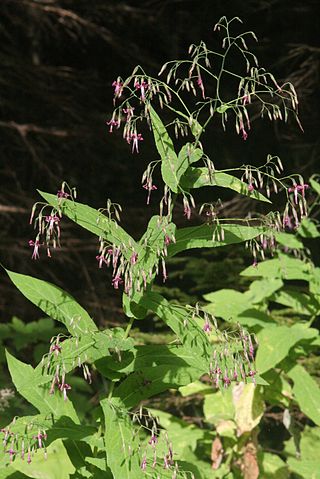
Matricaria discoidea, commonly known as pineappleweed, wild chamomile, disc mayweed, and rayless mayweed, is an annual plant native to North America and introduced to Eurasia where it grows as a common herb of fields, gardens, and roadsides. It is in the daisy family Asteraceae. The flowers exude a chamomile/pineapple aroma when crushed. They are edible and have been used in salads and to make herbal tea.

Hypochaeris radicata – also known as catsear, flatweed, cat's-ear, hairy cat's ear, or false dandelion – is a perennial, low-lying edible herb often found in lawns. The plant is native to Europe, but has also been introduced to the Americas, Japan, Australia, and New Zealand, where it can be an invasive weed. It is listed as a noxious weed in the northwestern U.S. state of Washington.

Gagea lutea, known as the yellow star-of-Bethlehem, is a Eurasian flowering plant species in the family Liliaceae. It is widespread in central Europe with scattered populations in Great Britain, Spain, and Norway to Siberia and Japan.

Hypochaeris is a genus of plants in the family Asteraceae. Many species are known as cat's ear. These are annual and perennial herbs generally bearing flower heads with yellow ray florets. These plants may resemble or be confused with dandelions and so some are called false dandelions.

Ononis spinosa is a flowering plant belonging to the family Fabaceae, that is commonly known as spiny restharrow or just restharrow. It is found throughout much of Europe including Britain, but seldom as far north as Scotland.

Lysimachia europaea is a flowering plant in the primrose family Primulaceae, called by the common name chickweed-wintergreen or arctic starflower. It is a small herbaceous perennial plant with one or more whorls of leaves on a single slender erect stem. It is about one third of a foot high (10 cm). The broad lanceolate leaves are pale green but take on a copper hue in late summer. The solitary white flowers are reminiscent of small wood anemones and appear in midsummer. The fruits are globular dry capsules but are seldom produced.

The Botanical Society of Britain and Ireland (BSBI) is a scientific society for the study of flora, plant distribution and taxonomy relating to Great Britain, Ireland, the Channel Islands and the Isle of Man. The society was founded as the Botanical Society of London in 1836, and became the Botanical Society of the British Isles, eventually changing to its current name in 2013. It includes both professional and amateur members and is the largest organisation devoted to botany in the British Isles. Its history is recounted in David Allen's book The Botanists.

Myosotis alpestris or alpine forget-me-not is a herbaceous perennial plant in the flowering plant family Boraginaceae. The alpine forget-me-not is the county flower of Westmorland in the United Kingdom.

Anthoxanthum odoratum is a short-lived perennial grass, commonly known as sweet vernal grass, that is native to acidic grassland in Eurasia and northern Africa. It is grown as a lawn grass and a house plant, due to its sweet scent, and can also be found on unimproved pastures and meadows. The specific epithet odoratum is Latin for 'odorous'.

Prenanthes is a genus of plant in the family Asteraceae, often referred to as rattlesnake root.

Urtica urens, commonly known as annual nettle, dwarf nettle, small nettle, dog nettle, or burning nettle, is a herbaceous annual flowering plant species in the nettle family Urticaceae. It is native to Eurasia, including the Himalayan regions of Kalimpong, Darjeeling and Sikkim in India and can be found in North America, New Zealand and South Africa as an introduced species. It is reputed to sting more strongly than common nettle.

Herminium monorchis, the musk orchid, is a commonly occurring species of orchid. It is widespread across much of Europe and northern Asia from France to Japan, including China, Siberia, Mongolia, Ukraine, Germany, Italy, Scandinavia, etc.

Ononis repens, the common restharrow, is a flowering plant species in the bean family Fabaceae. The name is synonym of Ononis spinosa subsp. procurrens.

Dactylorhiza incarnata, the early marsh-orchid, is a perennial, temperate-climate species of orchid generally found growing in wet meadows, and generally on base-rich soils, up to about 2100m asl. The species occurs widely in Europe and Asia from Portugal and Ireland east to Siberia and Xinjiang.

Dactylorhiza maculata, known as the heath spotted-orchid or moorland spotted orchid, is an herbaceous perennial plant of the family Orchidaceae. It is widespread in mountainous regions across much of Europe from Portugal and Iceland east to Russia. It is also found in Algeria, Morocco, and western Siberia.

Hypochaeris glabra is a species of flowering plant in the tribe Cichorieae within the family Asteraceae known by the common name smooth cat's ear. It is native to Europe, North Africa, and the Middle East but it can be found on other continents where it is an introduced species and a widespread weed. It has become widespread in Africa, southern and southeastern Asia, Australia, and parts of the Americas.

Artemisia campestris is a common and widespread species of plants in the sunflower family, Asteraceae. It is native to a wide region of Eurasia and North America. Common names include field wormwood, beach wormwood, northern wormwood, Breckland wormwood, boreal wormwood, Canadian wormwood, field sagewort and field mugwort.

Rosa majalis is a species of deciduous shrubs in the genus Rosa, native to forests of Europe and Siberia. It grows to 2 m. and yields edible hip fruits rich in vitamin C, which are used in medicine and to produce rose hip syrup.

Lithospermum purpurocaeruleum is a synonym for Aegonychon purpurocaeruleum (L.) Holub, also known as the purple gromwell, This plant is a herbaceous perennial rhizomatous flowering plant and it belongs to the family Boraginaceae.

Anemonoides apennina, the Apennine anemone or blue anemone, is a flowering plant in the family Ranunculaceae. It is a rhizomatous perennial plant, native to southern central Europe, taking its name from the Apennine Mountains, but widely naturalised elsewhere in Europe, including the United Kingdom. It can be confused with Anemonoides nemorosa which it resembles. It grows to 20 cm. In early spring it produces single blue flowers above ferny foliage, which dies down in summer. The flowers are about 3.5 cm across, with 10-15 narrow petals. The leaves are palmate with dark green 3-lobed, toothed leaflets. The leaves are hairy underneath, which is how this plant may be distinguished from the similar Anemone blanda. It is especially valued for its ability to colonise deciduous woodlands, but it is also found in open scrub, under park trees, and near former habitation. This plant has gained the Royal Horticultural Society's Award of Garden Merit.




















